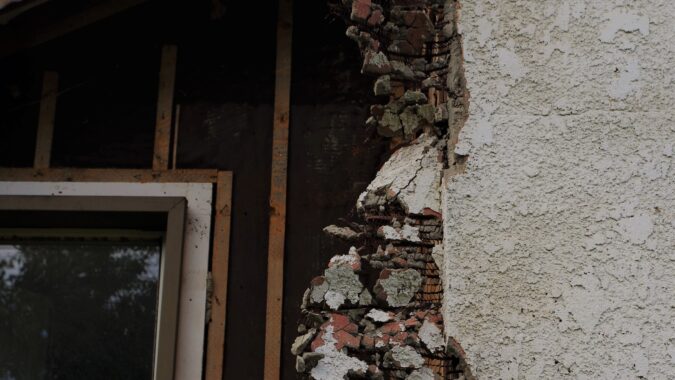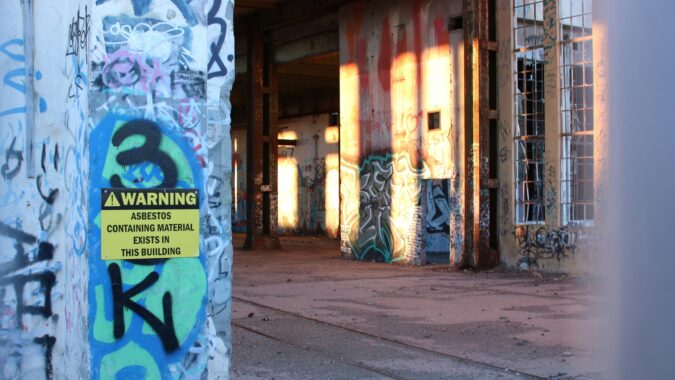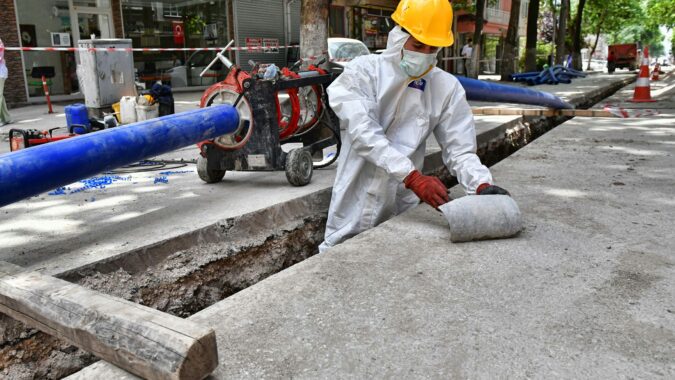
Asbestos Disposal Guide
Disposing of asbestos in any building, business, or home must be done incredibly carefully to protect the health of those around and the environment. This hazardous and dangerous material is linked to various health conditions. Therefore, safe handling, removal, storage, and disposal by professionals is essential.
Asbestos is still found in many buildings even though it has been banned in the UK for decades. This guide aims to answer common questions about asbestos waste and disposal to ensure you treat it seriously and follow the proper processes to get rid of it safely.
If you have any concerns or queries about asbestos then one of our friendly and experienced team can help – call 0800 211 8390 or contact us online. Otherwise, discover everything you need to know about disposing of asbestos safely with these expert answers to frequently asked questions.
Get a free quote
Get a fast FREE quote for asbestos disposal
- Free quote within 1 hr
- Any type of asbestos
- FREE bins and delivery
- We cover all of the UK
What is asbestos?
Asbestos is the name for a group of six naturally occurring fibrous minerals, which crystalise to create fibres. These fibres can be separated and used in various products due to their heat-resistant properties, strength, and durability. However, they’re also toxic and carcinogenic, so they pose a serious health risk due to exposure.
Asbestos comes from the Greek word for inextinguishable. It refers to two distinct groups of fibrous minerals (comprised of six individual types) found naturally in the earth:
- Chrysotile or white asbestos, a magnesium silicate, derived from serpentine rock.
- Amosite or brown asbestos and crocidolite or blue asbestos (anthophyllite, tremolite and actinolite – of a lesser commercial significance) derived from amphibole rock.
There are at least 30 types of asbestiform minerals but only these two have any industrial significance. Different asbestos types have good resistance to high temperatures, acids and alkalis, which made them great for construction and industrial use – until links between exposure to asbestos and serious diseases were made.

What materials contain asbestos?
A wide range of materials can contain asbestos. It’s mainly found in items within buildings such as:
- Cement pipes and fittings
- Paints, coatings, and sealants
- Fire hoses
- Coal and wood-burning stove gaskets
- Theatre curtains
Within the home, some items that may include asbestos are:
- Handheld dryers
- Electric blankets
- Lamp sockets
- Roof slates
- Windowsills, bath panels, draining boards, worktops, and ducts
How to dispose of asbestos
To dispose of asbestos from a business or home you should use a professional asbestos removal service. They will come and assess where the asbestos is located, put in place a safe plan to remove it and dispose of it responsibly. Asbestos cannot be reused or recycled.
This is the safest option and ensures compliance with the Control of Asbestos Regulations 2012. These dictate that only licensed contractors and trained individuals can handle and remove certain asbestos-containing materials. If the asbestos waste is already removed, it should be double-bagged and collected by licensed waste carriers to transport it to a disposal site.
Householders can see if your local council or authority provides a hazardous waste disposal service. Some Household Waste Recycling Centres (HWRCs) may allow the disposal of asbestos at their sites too. Check if your local one does and the rules around asbestos disposal. If asbestos needs removing from a building then you should use professionals though.
Most may require the asbestos to be double-bagged or wrapped in strong polythene with a minimum gauge (often at least 1000 gauge). This must also be sealed and secure. You should also wear personal protective equipment (PPE) including gloves, a mask, protective footwear, and a high-vis jacket. It’s usually easier and safer to use a professional asbestos removal service.
How much does asbestos removal cost?
The cost of asbestos waste removal depends on many factors. These include:
- If the asbestos is in a home, commercial, or industrial property
- The type of asbestos material
- Size and complexity of the area
- What the asbestos is in (tile, insulation, paint etc.)
- When and where you require removal
- Its weight and related disposal fees
The easiest way to find the price for asbestos waste removal is to get a tailored quote that’s bespoke to your specific needs – call 0800 211 8390 or contact us online.

How long does it take
to remove asbestos?
How long it takes to remove asbestos depends on the size of the area where it is and the complexity of removing it. Getting rid of asbestos tiles from a garage roof or within a single room could be done in a day. However, removing asbestos from an industrial site may take weeks.
Before any asbestos is removed the professionals should undertake a site visit and put together a plan. This should include a timeline and estimation of how long the removal process will take. Preparation, the size of the team, types of asbestos materials, accessibility, and any issues that may cause delays all affect how long asbestos removal takes.
When does asbestos
become a hazard?
Asbestos isn’t always an immediate hazard, but when identified it should be removed as soon as possible. Only when you disturb or damage asbestos-containing materials (ACM) does the risk of exposure increase. Damage to the materials can separate the fibres so they become airborne and hazardous.
Why is asbestos a hazard?
It was discovered in the 1930s that when microscopic asbestos fibres (up to 100 times finer than a human hair) become airborne, you may inhale them. The fibres are so slow to move that they can’t be dispelled from the lungs and can cause cancer. When asbestos is disturbed, these fibres can be inhaled and cause significant respiratory health problems.
Researchers still haven’t determined a safe level of exposure. We know the greater and longer the exposure, the higher risk of contracting an asbestos-related disease.
Asbestos-related diseases kill more people than any other single work-related cause in the UK. There’s a long period between exposure and the onset of the disease (15 to 60 years). Therefore, most associated deaths today are from exposure during the 1950s, 1960s, and 1970s when asbestos was widely used.
Can you remove asbestos yourself?
You should never try to remove asbestos yourself, as once it’s disturbed it can release fibres that may cause disease in later life. The Health and Safety Executive (HSE) has stringent regulations for asbestos waste removal – normally licensed asbestos removal contractors should handle it.
If you find asbestos, carry out a thorough risk assessment and restrict the number of people with access to as few as possible. Anyone dealing with asbestos removal should refer to the HSE’s EM9 sheet, which lays out the law for handling it wherever you are in the UK.
HSE direction says all asbestos waste should be double-bagged or double-wrapped in stout plastic sheeting with the correct warning signs attached. If a skip is used, it must be lockable and for asbestos waste only. It’s not acceptable or safe to put asbestos waste – no matter how well wrapped – in a standard skip.
The best thing to do is to leave asbestos waste disposal to professionals. They know what they’re doing, have effective procedures in place, and will remove hazardous waste with skill and care to make sure nobody and nothing remains contaminated.

Who can remove asbestos?
High-risk asbestos removal can only be done by licensed contractors, according to the Health and Safety Executive (HSE). This includes the removal of asbestos insulation (lagging on pipes), sprayed asbestos, and insulation boards (ceilings and partition walls). Using a licensed contractor is always the safest option anyway.
Non-licensed individuals can remove low-risk asbestos. Examples include removing small areas of decorative coatings when replacing light fittings or smoke alarms, loosely fixed asbestos insulation board panels, or roof sheeting when it’s handled carefully without breaking up. However, you should always consult a licensed contractor for advice before doing any such work.
Where can I dispose of asbestos?
You can dispose of asbestos by arranging removal by a licensed asbestos specialist. They will come to your business or home and transport the asbestos materials for safe disposal at an appropriate facility. Services are available to remove asbestos from the structure or to simply collect bagged-up asbestos ready for disposal.
To dispose of asbestos from a household you should contact your local council or authority to see what asbestos disposal services are available. This may include a collection service, or you might be able to dispose of asbestos at your local tip or household waste recycling centre (HWRC). Options vary depending on your location.
Can you put asbestos in a skip?
To dispose of asbestos, you must double bag it – ideally in specific asbestos waste bags – or secure it safely. Then you can place it in a covered and locked skip with just asbestos waste or other hazardous waste to avoid contamination. Always check with the skip provider or asbestos waste collection company whether you can put asbestos in a skip or not.
Can asbestos be recycled?
Asbestos is a hazardous material that you cannot recycle in the UK. Waste asbestos goes to landfill with a specific permit allowing the site to accept asbestos. Research is ongoing to try and develop safe and environmentally friendly ways to convert asbestos into new materials. However, legally it must go to landfill in the UK currently.
How do you dispose of
asbestos sheets in the UK?
Safe asbestos sheet disposal is vital for any business or home to reduce the risk of exposure to hazardous materials. Handle any sheets with care and wear gloves, a dust mask, and goggles. Avoid touching and breaking up asbestos sheets where possible, as this increases the risk of exposure to dangerous dust.
Asbestos sheet disposal follows the same steps as getting rid of any other kind of asbestos. The best option is to use a specialist asbestos removal contractor to collect and dispose of any sheets. Households should contact their local authority to see if they provide an asbestos collection service or if you can take asbestos sheets to the tip for safe disposal.
How long has asbestos
been used for?
Some of the first evidence of asbestos dates back around 4,500 years in Finland. Here it was used to strengthen pots and utensils. In the UK, its history is more recent when ships, steam engines and other power-generating machinery began to take advantage of its properties in the 1870s.
The main sources of chrysotile asbestos – the commonest fibre in industrial use – were first mined in Quebec, British Columbia, South Africa, Russia, Italy, America, Greece, and Cyprus. Crocidolite was mined in South Africa and Australia, while amosite was mined in Australia and South Africa (the name amosite derives from AMOSA – Asbestos Mines of South Africa).
What are the different types of
diseases asbestos causes?
Asbestos exposure can lead to a range of serious and possibly fatal diseases many years later. Some of the main types of diseases asbestos exposure may cause include:
- Asbestosis– Inhaling asbestos dust can lead to asbestosis, which normally takes at least ten years to emerge. It involves scarring the lungs and symptoms include breathlessness, constant coughing, and wheezing.
- Mesothelioma – This is a common type of cancer in the lining of the lungs that often takes many years to develop after asbestos exposure. The fibres get stuck in the lungs and damage them.
- Bronchial and lung cancer – Various types of lung cancer are common after developing asbestosis, including bronchial cancer. Tumours may develop in the lungs and lung linings, but it normally takes 15 to 30 years to emerge.
- Pleural plaques – Thickened tissue in the lining of the lungs can be pleural plaques, which are noncancerous. Often there may be no symptoms, but they can cause pain and discomfort in the lungs and are a sign of asbestos exposure.
- Pleural effusion – A build-up of excess fluid between pleura layers (the lung and chest wall) leads to pleural effusion. This may develop into pleural thickening and be linked to inhaling asbestos fibres.
- Diffuse pleural thickening – Scarring in the pleura because of asbestos exposure may affect one or both lungs. This can cause thickening and constriction of the lungs, often leading to pleurisy and breathlessness. It could indicate mesothelioma or lung disease.
Get a fast and free quote
Get a fast FREE quote for your asbestos waste collection
- Free quote within 1 hr
- Any type of asbestos waste
- FREE bins and delivery
- We cover all of the UK
Published 20th June 2025 by Graham Matthews. Last modified 9th July 2025